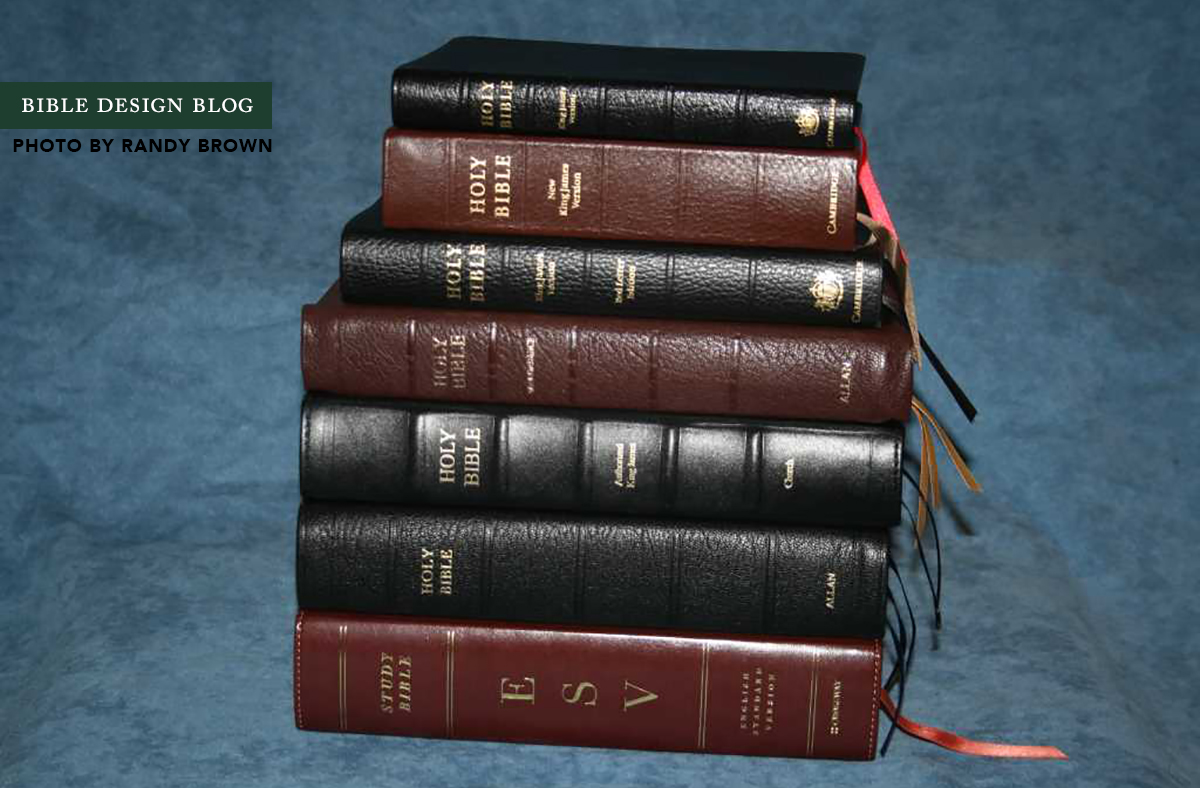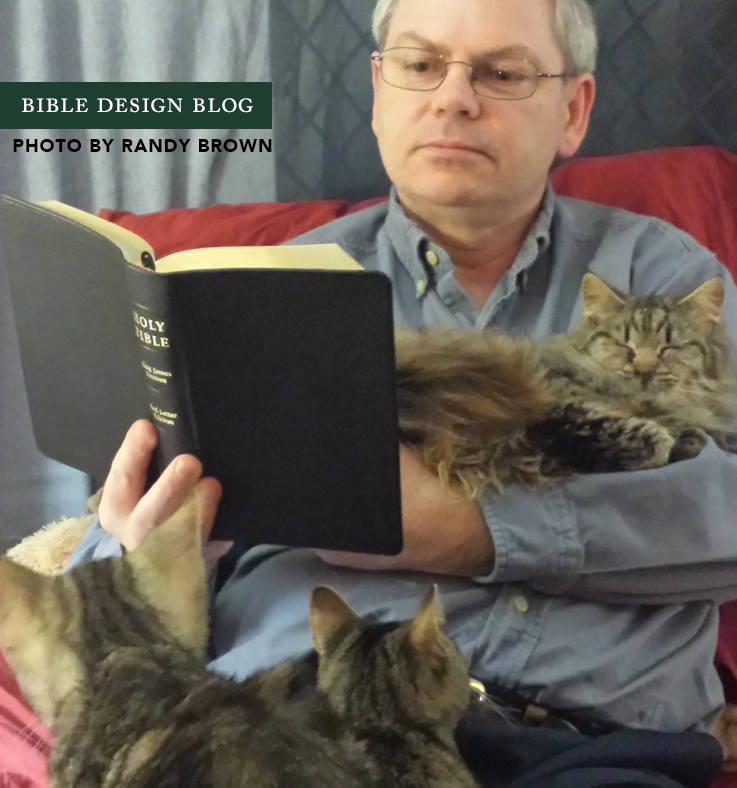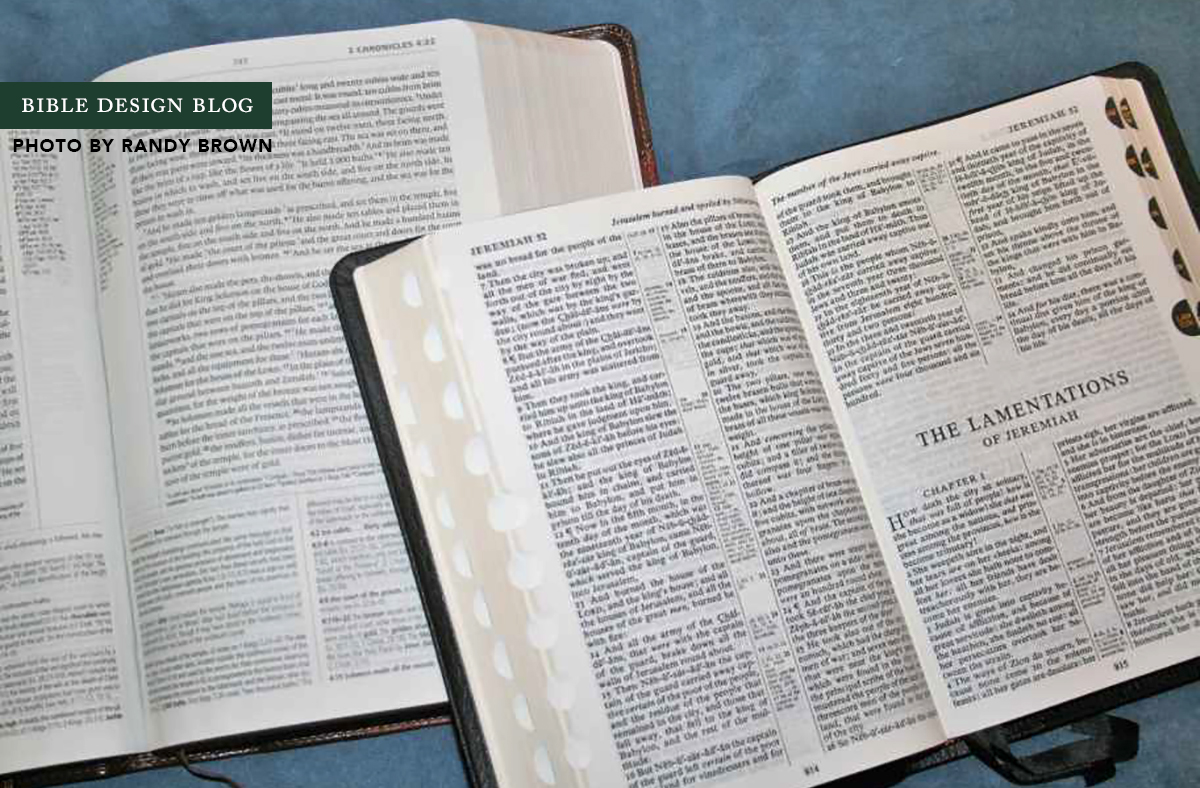Why You Need More than One Bible: A Guest Post
Way back when, I was pretty much a lone voice when it came to writing about the design and manufacture of quality Bibles. It's not like that anymore, and hasn't been for awhile. Against all my expectations, an ever-expanding network of enthusiasts has grown around Bible Design Blog. There are other blogs, there are online discussion groups -- in short, a community was born. Now I'd like to showcase some of the voices of that community. One way I'm going to do this is by inviting people whose work I've admired to contribute guest posts to Bible Design Blog. Today I'm sharing the first one, a thoughtful feature by Randy Brown, creator of BibleBuyingGuide.com. I think you'll enjoy what Randy has to say.
-- JMB
Why You Need More than One Bible
BY RANDY BROWN
Starting with One
Like Mark, I’ve spent a lot of time and research trying to find that ‘One Bible.’ The Bible I could do everything with. It would be the Bible I read from, carried with me, studied from, studied in, taught from, and preached from. I searched for a long time for this one Bible and now I don’t believe it exists.
I found many Bibles that had features I liked, but I never found a Bible that had all the features I wanted. If I liked the font for reading, it was either too large to carry or had nothing else in it. If it had everything in it I wanted, the font had to be small to make it all fit.
This is the problem of the “Jack of all trades” Bible. A Bible that tries to fill every purpose and do everything doesn’t really do any one of them well. What’s a better solution? Use more than one Bible. Figure out how many different ways you use a Bible – what all of your different needs are – and use the best Bible you can for each purpose.
How many Bibles you need depends on how you use your Bible. I will use myself as an example and show how I use my Bible. This will determine what my needs are, how big or small it needs to be, how large of a font I need, and what tools I need it to supply.
Here’s what I use my Bibles for:
- Read
- Study
- Mark
- Carry
- Teach
- Preach
Let’s take a closer look at each of these uses.
One for Reading
When I’m doing my everyday reading I like to use a comfortable font. Sometimes I read my Bible at my desk or at the table. In this case, the size of the Bible doesn’t really matter. Most of the time though, I like to lay the Bible on my lap and read from my favorite chair. Sometimes a little kitten wants my lap. And of course its little kitten friend also wants my lap. And then the kitten’s momma. The next thing I know I have a kitten on my shoulder, one on my lap, and the momma cat laying like a baby across one arm (okay, I’ll admit she’s spoiled a little). Now I need to hold the Bible in one hand while I read.
That’s not a Study Bible. It might not even be a Bible with large print. It’s definitely not a large Bible. Also, I don’t need extra information distracting me and trying to tell me what to think about a passage. I just want to read. This Bible might not even need references or a concordance. Or verse numbers for that matter.
So I need a Bible just for reading, with a nice enough font and no distractions. This most likely won’t be the Bible I use for sermon prep or for preaching from, and I might not carry it with me.
One to Study In
I like marking in my Bibles. Wide Margin and Journaling Bibles are great for this. It’s a way of inductively studying God’s Word. It also helps me find things quickly as I’m scanning the page. I like making chain references and writing definitions. A Bible that I’ve written all of my notes in isn’t a good choice for reading. I like to read a Bible unhindered – without any distractions. I need one that I can write in and mark up and it won’t be my reading Bible. This could be the Bible I preach from, but it’s probably not the Bible I do my daily reading from.
One to Study From
For study I like Bibles that make life easier without giving me the answers (or their version of the answers). To me a good Study Bible is a Bible that gives you good tools to do your own study. This usually means Bibles with charts, topical lists, word studies, etc. -- the Longprimer, Thompson Chain Reference, and Hebrew Greek Keyword Study Bible are a few good examples. They’re not exhaustive, but they do have some good tools. Some of the tools don’t take up much space, but they can get quite extensive. For example, the Thompson Chain Reference has an archaeological supplement that takes many pages. I like to be able to go to a chart to quickly find any miracle or parable of Jesus. That’s good to have for study and sermon prep, but I don’t need to have that information with me when I’m out somewhere. I don’t need it when I’m holding my Bible in my hand for my daily reading.
The same can be said for Study Bibles with commentary. I love extras, but I don’t always need them with me. I especially enjoy archaeological facts. I enjoy using Bibles that are filled with archaeological information. Information about cultures, places, historic events, and facts about everything. I also like Hebrew and Greek word studies, topical lists, dictionaries, and maps. They can’t really replace the tools you would use as your desk-reference material: commentaries, concordances, dictionaries, etc. They just provide some good basic info in one convenient volume. If I use a Study Bible for study and prep, I’m just as likely to use more than one.
The more I carried these features around with me the more I realized I didn’t need to have it with me. These things are great for study at home, but if I’m sitting in the pew, or standing behind the pulpit, the chances of me needing a full bio of Xerxes is, well . . . I don’t. Okay then, that means I don’t need to carry a study Bible. Those can stay at home.
One to Carry
I love reading the Bible in the car when I’m waiting for my wife and her mother to finish their shopping. (I love the reading part, not the waiting part.) I’ve tried every type of Bible I own -- well, except for a gigantic loose leaf from Hendrickson. That one won’t fit in the front seat. I find that the personal size or smaller is perfect for front-seat, behind the wheel reading.
Phones and tablets are convenient for this, but I like my Bible to look like a Bible. I want others to see that this book is still being read. This has sparked many conversations in parking lots that never would have happened if I was holding a phone. I also don’t want to worry about a battery. I’ve left home thinking I could just use my fully charged phone to read from only to find that some app was draining power so fast that it wasn’t usable by the time I got there. Now I take a printed Bible.
If I’m just reading, then I only need a good text that’s comfortable to read and hold. Every now and then someone will ask a question that I need to look at the verse to answer. If this happens I might need a good concordance, a topical index, harmony of the Gospels, charts of parables, and so on. I decided I wasn’t going to carry these tools for ‘just in case’ when I can look up anything I need to on my phone (fully charged with no apps running in the background, of course). If I did want these tools I would use a hand-sized Bible like a Cameo, Brevier Clarendon, Clarion, or similar. This Bible needs to be easy to carry and read. Basic tools are fine, but not necessary.
Sometimes I don’t feel comfortable carrying an expensive Bible. Sometimes I like to have a ‘beater’ that I can throw around and not worry about what happens to it.
One to Preach From
Every preacher is different. My preferences might be completely different from yours. I know they’re different from Mark’s -- the present-day writer, not the Gospel writer. (I’ve read somewhere that they’re not related, but I haven’t confirmed that myself). I prefer to preach from a verse-by-verse format with columns that are not too wide. Why? I wear bifocals and if the columns are too wide, the edge of the column is out of focus and it’s hard to read without moving to the side a little (very minor complaint, but still). Single column paragraphs can be too wide for me. Also, if I’m reading at an angle I tend to not know which line to start on when I get back to the start of the next line.
Verse numbers can be difficult to find and I spend an extra second or five looking (an extra pause can be a good thing, though). I like to place my finger on the verse where I’m stopping. If I have trouble finding the reference that can be difficult. This is partly my inexperience with paragraph format behind the pulpit. It’s also partly that I’m always using a different Bible, which keeps me from having any kind of location muscle memory. I’ll settle on one soon, though. Then I’ll remember where all of the verses are. I keep telling myself that. With that said, I love paragraph format for reading. The text flows much better. So, I like having at least one of each format.
Having commentary, study tools, maps, and character bios is nice for personal study, but I don’t need them behind the pulpit. The Bible I prepared my message in will most likely be a different Bible than the one I’m preaching it from. For sermon prep I need tools, but for preaching I don’t want any distractions.
One to Teach From
For teaching I might actually use a Bible with distractions in it. I might want chain references, word studies, maps, character studies, etc., to help me bring out a point in more detail. I might teach from a Study Bible, or the Bible I write my notes in. I might read a quote from a note or an article. I might teach directly from a chart. If I decide to use a Study Bible to teach from, I’m just as likely to use more than one. Although, I might only use one at a time. This might be the Bible I study from, but it isn’t the Bible I read from, carry, or preach from.
Electronic Bibles
It would seem then that an electronic Bible would solve all of these problems. You can use a tablet or a smartphone that’s easy to hold in one hand. You can have as many translations as you want. You can make the font any size and style you want. You can add your own notes and choose to see them or not, you can color-code, underline, highlight, etc., and turn them on and off as you want to.
While an electronic Bible would solve these problems they also bring with them other problems of their own. The first being the most obvious: battery life. I’ve charged my phone and left the house without taking a Bible with me because, “I’ve got my phone. I’ll just use that.” Only to find that by the time I got to where I was going my battery was dead because of an app running in the background.
Then there’s the distraction this causes to others. People look at you and wonder, “what’s he doing?” I like it to be obvious that I’m holding a Bible. This alone is a witness to others.
I love being able to carry 50 study Bibles in my pocket; I just don’t want that to be the only format I have with me. I love electronic Bibles and I use them, but they will never replace my paper bound Bible. I don’t choose one or the other -- I choose both.
For on the go I like using a good basic Bible without all the extras and then use my phone if I need that bio of Xerxes.
Translations
Perhaps the best reason that anyone would need more than one Bible is so they have access to more than one translation. My church uses the KJV as our primary Bible. I love the translation. It’s beautiful to read and it sounds right to me. However, when I’m teaching or preaching I sometimes like to bring in other translations just to add clarity. Old English isn’t as easy to understand as modern English (well, most modern English).
Even for personal study, looking up a verse or passage in a different translation is a great way to get clarity. I like to have one primary translation, and then one or two supporting, and reputable, translations to add variety.
No translation is perfect as words can have a range of meanings. To make things worse, words can change meaning over time. Multiple translations can help clarify passages of Scripture and help you see a verse in a different way. There is also the point of manuscript variance. It isn’t usually a doctrinal issue, but there are variants and having a translation based on a different manuscript can be helpful in understanding these variants. It also helps to know what others are reading.
From One to Many
I started out looking for one Bible to rule them all and quickly had to use more than one because no one Bible fits every purpose. There are many different needs and it is sometimes best to have a specific Bible to fit a specific need. Having to use more than one Bible to meet these needs is not a burden. There is true virtue in using more than one Bible – whether it be size, features, tools, translation, a look and feel that melts in your hands and calls you to it, or one that you can use anywhere without worrying what happens to it.
I need one for reading, one to study in, one to study from, one to carry, one to preach from, one to teach from, and another translation to support all of these uses. Some of these uses can be combined. My daily reader can be my carry Bible. I can use the same Bible for sermon prep and marking. I can use the same Bible for study that I use for teaching. I’ve preached from all of them, but I prefer to preach from a large print Bible with no distractions other than what I’ve written myself.
That can be a lot of Bibles to buy and keep up with, but each one would suit its purpose better than any other. Sure, I could simply pick a Longprimer, Concord, or Westminster and be satisfied. After all, those are amazing Bibles. However, in our world of choices, and for all of those vastly different uses for a Bible, it’s a good investment to own and use more than one instead trying to find that one Bible that I could settle for that would do many things but none of them well.
About Randy
Today’s guest post is by Randy Brown, creator of BibleBuyingGuide.com. Randy reviews Bibles in all price ranges to help people make the best choice for their budget. His mission is to promote Bible reading and study, and to share quality publishing.
Message from Randy: I’d like to give a special thank-you to Mark for allowing me to guest post on Bible Design Blog. It is truly an honor. Thanks Mark!
Your Turn
How about you? Have you been able to find that one Bible that does everything you need it to? Do you use more than one?
J. Mark Bertrand is a novelist and pastor whose writing on Bible design has helped spark a publishing revolution. Mark is the author of Rethinking Worldview: Learning to Think, Live, and Speak in This World (Crossway, 2007), as well as the novels Back on Murder, Pattern of Wounds, and Nothing to Hide—described as a “series worth getting attached to” (Christianity Today) by “a major crime fiction talent” (Weekly Standard) in the vein of Michael Connelly, Ian Rankin, and Henning Mankell.
Mark has a BA in English Literature from Union University, an MFA in Creative Writing from the University of Houston, and an M.Div. from Heidelberg Theological Seminary. Through his influential Bible Design Blog, Mark has championed a new generation of readable Bibles. He is a founding member of the steering committee of the Society of Bible Craftsmanship, and chairs the Society’s Award Committee. His work was featured in the November 2021 issue of FaithLife’s Bible Study Magazine.
Mark also serves on the board of Worldview Academy, where he has been a member of the faculty of theology since 2003. Since 2017, he has been an ordained teaching elder in the Presbyterian Church in America. He and his wife Laurie life in Sioux Falls, South Dakota.







